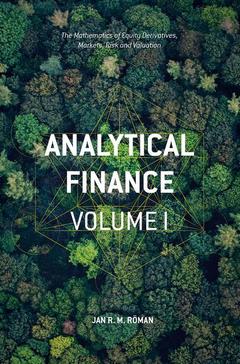Description
Analytical Finance: Volume I, 1st ed. 2017
The Mathematics of Equity Derivatives, Markets, Risk and Valuation
Author: Röman Jan R. M.
Language: English
Subjects for Analytical Finance: Volume I:
Support: Print on demand
Description
/li>Contents
/li>Biography
/li>Comment
/li>
This book provides an introduction to the valuation of financial instruments on equity markets. Written from the perspective of trading, risk management and quantitative research functions and written by a practitioner with many years? experience in markets and in academia, it provides a valuable learning tool for students and new entrants to these markets.
Coverage includes:
·Trading and sources of risk, including credit and counterparty risk, market and model risks, settlement and Herstatt risks.
·Numerical methods including discrete-time methods, finite different methods, binomial models and Monte Carlo simulations.
·Probability theory and stochastic processes from the financial modeling perspective, including probability spaces, sigma algebras, measures and filtrations.
·Continuous time models such as Black-Scholes-Merton; Delta-hedging and Delta-Gamma-hedging; general diffusion models and how to solve Partial Differential Equation using theFeynmann-Kac representation.
·The trading, structuring and hedging several kinds of exotic options, including: Binary/Digital options; Barrier options; Lookbacks; Asian options; Chooses; Forward options; Ratchets; Compounded options; Basket options; Exchange and Currency-linked options; Pay later options and Quantos.
·A detailed explanation of how to construct synthetic instruments and strategies for different market conditions, discussing more than 30 different option strategies.
With source code for many of the models featured in the book provided and extensive examples and illustrations throughout, this book provides a comprehensive introduction to this topic and will prove an invaluable learning tool and reference for anyone studying or working in this field.
Jan Röman is Senior Lecturer, Mälardaran University, where he teaches analytical finance and financial engineering. He is also a financial engineer in the Quantitative Risk Modelling Group at Swedbank Robur Funds, where he specializes in risk model validation, focusing on all inputs to front office systems including interest rates and volatility structures. Jan has over 16 years financial markets experience mostly in financial modeling and valuation in derivatives environments. He has held positions as Head of Market and Credit Risk, Swedbank Markets, Senior Risk Analyst at the Swedish financial Supervisory Authority, Senior Developer at SunGard and Senior Developer, OMX Stockholm Exchange. He holds a License degree in Theoretical Physics from Chalmers University of Technologyand hasreceived a scholarship of the Nordic Minister Council to research at NORDITA, the Nordic Institute for Theoretical Physics.




